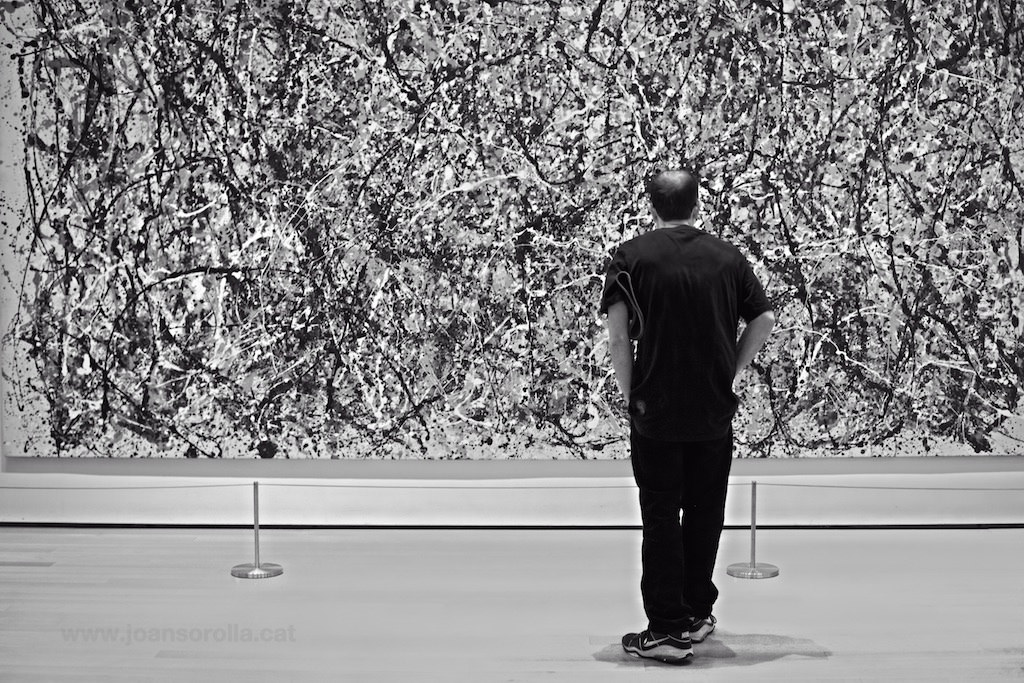Main Body
2. Abstract Painting in the 1950s
Clayton Funk

Abstract Expressionism is a form of art (mainly painting) that developed after one of the most difficult periods in human history. This period began during the great depression in the 1930’s and ended with the end of World War II in 1945. When the war ended, Germany, Italy and Japan had been defeated and much of Europe and Japan were in ruins. The human loss in the Nazi concentration camps had been exposed in all of its horror and the United States had dropped atomic bombs on two Japanese cities, unleashing destructive power of an unprecedented nature. All of this, of course brought about a worldwide examination of basic human values and ethics and a period of dramatic change in art.
Although both the Great Depression and World War II were great disasters, these events were important in forcing a number of the European avant-garde artists to flee Europe for the safety of the Americas, where they also influenced many younger artists in the United States. It is difficult to know exactly how much this migration affected American art, but part of its impact was that for the first time, American artists became internationally recognized for their new vision and a new artistic vocabulary, all of which soon became known as Abstract Expressionism.
These artists, like others earlier in the century, began to express their feelings and thoughts in abstract form. However, the difference here was that they expressed these abstract ideas and feelings with an energy that had never been seen before as they tried to draw upon their deepest essence, or a pure expression, from which generated excitement and even torment into a concrete form. They also took artistic license to an extreme that had never been seen before; and in doing so, they redefined what could be considered art and artistic process.
Because this art movement was centered in New York, it is often referred to as the “New York School.” But Abstract Expressionism is often called “Action Painting” because the movement of painting, they felt, drew from innate parts of the artist’s mind. These artists often applied paint rapidly, painting on large canvases, sometimes applying paint with large brushes, sometimes dripping the paint onto the canvas or even throwing it onto the canvas. What appears to be painting done by accident, chance and random activity, was actually the result of planned and highly controlled attempts to tap what they considered was most essential and true in the subconscious. In this way, they often considered the process of making the painting as important as the painting itself.
Like most other modern movements, which have been defined by critics and historians rather than artists, Abstract Expressionism does not describe only one particular style, but rather signifies an attitude toward making art. Confusing as it may seem, not all the work classified as Abstract Expressionism was abstract, nor was it all expressive, at least on a grand scale. This art stood in sharp contrast to the social realism and regionalism that characterized American art of earlier years, and the Abstract Expressionist artists valued, more than anything, their individuality and spontaneous improvisation of their artistic methods. This attitude was also characterized by a spirit of revolt and an intense belief in freedom of expression.
Now we turn to reading biographies of major Abstract Expressionists. Read the artists under Abstract Expressionism on the web book menu at http://aaep1600.osu.edu/book/menu1950s.php
Or follow this list:
Others include Hans Hofmann, Franz Kline, Clyfford Still, Robert Motherwell and Sam Francis.
Post-painterly Abstraction
Post-painterly Abstraction is a movement given its name by the prominent American art critic, Clement Greenberg (as in the video above), in 1964, to distinguish a certain type of abstract painting of the 1960’s and after from the Abstract Expressionists of the 1940’s and 1950’s. The paintings of the abstract expressionists often involved a very strong personal and emotional approach to painting, expressed through a “painterly” quality involving spontaneous, very visible, and often vigorous brushwork.
Helen Frankenthaler, the most prominent of this second generation Abstract Expressionists, had begun to eliminate this “painterly” approach through the use of thin stains of paint on ungessoed (raw) canvas in the 1950’s.
The artists classified as Post-painterly Abstractionists, influenced by Frankenthaler’s groundbreaking work, approached painting with a more impersonal, austere, and intellectual aesthetic. Their paintings dealt with the formal elements of abstract painting: pure or often unmodulated areas of color; a flat, two-dimensional space within the painting; monumental scale; and in the work of Stella and occasionally Noland, the rejection of the traditional rectangle as the shape of the canvas itself.
They also rejected the painterly and spontaneous style of the Abstract Expressionists and instead they often stained raw canvas with thin wet paint to avoid any trace of brushstrokes. Among the styles included in the term post-painterly abstraction are “minimal painting” and “color-field painting.”
Important painters associated post-painterly abstraction include Ellsworth Kelly, Morris Louis, Kenneth Noland, Jules Olitski, and Frank Stella.
Now we turn to reading biographies of major painters. Read the artists under Post-painterly Abstraction on the web book menu at http://aaep1600.osu.edu/book/menu1950s.php
Or just follow this list:
